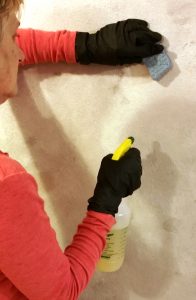How To Get Grease Off Walls
AnswerLine calls are a great resource for blog topics. Today's blog comes from an AnswerLine caller who wanted to know how to clean cooking grease from a painted kitchen wall.
Grease stains on any surface can be an intimidating problem. They are both unsightly and difficult to remove. Due to meal preparations involving cooking, sauteing and frying, the kitchen is the most common area in the home where grease stains occur; not only are the spatters of concern, but also the fine mist that gradually collects on walls and other surfaces. The longer grease, and especially cooking grease, is left on any surface, the more difficult it is to remove; over time it tends to gel and bond to the host surface. Further, the more porous the surface is, the more difficult the grease is to remove. Even after the stickiness is gone, there is often some discoloration to the surface, especially a painted wall, which will likely require repainting. Since one can never be totally sure that all the grease has been removed, it is a good idea to prime the wall with a KILZ paint to make sure that the stain will not eventually show through the new paint.
 Here's some common household items that will help remove grease stains from painted walls:
Here's some common household items that will help remove grease stains from painted walls:
- White vinegar. Mix one part white vinegar with one part hot water. Use a spray bottle to apply the solution to the grease. Allow it to set for several minutes and then wipe with a clean rag. Work in small areas and repeat as many times as necessary to get the wall clean. If the area is large, use several rags to collect the grease.
- Baking soda. Make a paste of three tablespoons of baking soda with one cup of warm water. Work the paste into the grease stain. Gently rub the area with a nylon scrubber until the stain disappears. Wipe clean with a clean damp rag.
- Ammonia. Mix two cups of household ammonia with one gallon of hot water. Use a spray bottle to apply the solution and scrub with a nylon sponge or brush to remove the stains. Gloves and ventilation are a must when using ammonia.
- TSP (Trisodium Phosphate). TSP is a strong cleaner. It can cause irritation and even burn if it is used incorrectly. Wear rubber gloves, safety goggles, and long sleeves to protect your skin and eyes. Surfaces outside of the affected area should be protected from TSP splashes as it can discolor or de-gloss paint, wood, and metal. A solution of ¼ cup TSP per gallon of very warm water is a good place to start. For heavy grease build up, increase the ratio to ½ cup TSP per gallon of water. Use a sponge to apply the solution, wringing out the sponge to avoid dripping. Working from the bottom up reduces streaking. Allow the solution to sit on the wall for two minutes to soften the grease before scrubbing with a nylon scrub pad. Rinse the affected area thoroughly as any residue left on the wall could prevent paint from adhering.

Marlene Geiger
I am a graduate of the University of Nebraska-Lincoln with a BS in Home Economics Education and Extension and from Colorado State University with a MS in Textiles and Clothing. I enjoy spending time with family and friends, gardening, quilting, cooking, sewing, and sharing knowledge and experience with others.
More Posts
How To Get Grease Off Walls
Source: https://blogs.extension.iastate.edu/answerline/2017/03/16/removing-grease-from-painted-walls/#:~:text=Mix%20one%20part%20white%20vinegar,to%20get%20the%20wall%20clean.
Posted by: pardonound1973.blogspot.com

0 Response to "How To Get Grease Off Walls"
Post a Comment